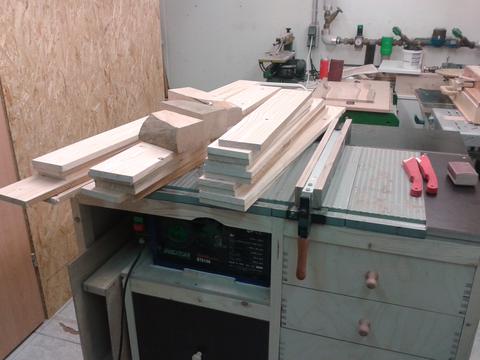
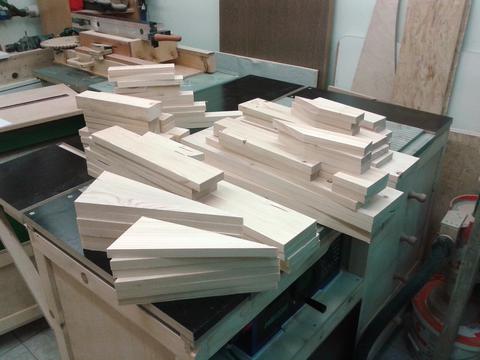
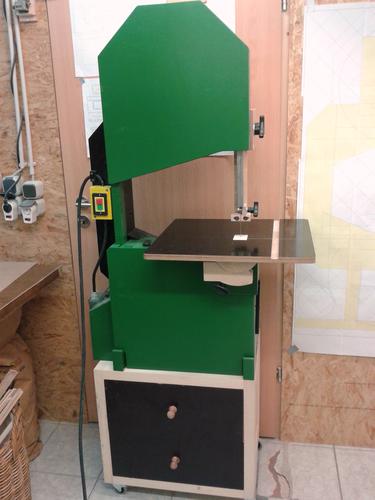 Hi Matthias,
Hi Matthias,
I bought the bandsaw plans right back in November 2013 and finished the saw in February after about 4 weeks of building time. So far it works great and made my "life in the workshop" a lot easier. And all in all it wasn't really that expensive, cause I got lots of stuff for free:
| Wood: | free |
| Plywood: | 40€ |
| Bearings and shafts: | free |
| Motor: | 10€ |
| Belt: | 2€ (don't know why it was so cheap) |
| Power switch: | 5€ |
| Casters: | 20€ |
| 4 bandsaw blades: | 90€ |
This is the wood that I got planed and rough cut from my grandfather for free. And after a little bit of time on the table saw, these boards gave me all the pieces that I needed for the bandsaw frame.
 I got 6 used bearings for free and they were in a really good shape, actually
2 of them were new. I have two hole saws the right size to make the holes for
the flanges, but interestingly the cheap one made a better sized hole.
I got 6 used bearings for free and they were in a really good shape, actually
2 of them were new. I have two hole saws the right size to make the holes for
the flanges, but interestingly the cheap one made a better sized hole.
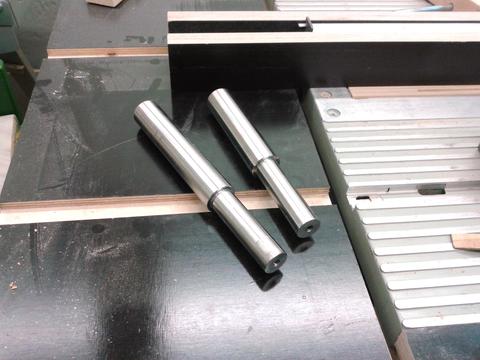 My dad then made the custom shaped shafts for me out of some really
tough steel. The ends of them are drilled and tapped to secure the
wheels.
My dad then made the custom shaped shafts for me out of some really
tough steel. The ends of them are drilled and tapped to secure the
wheels.
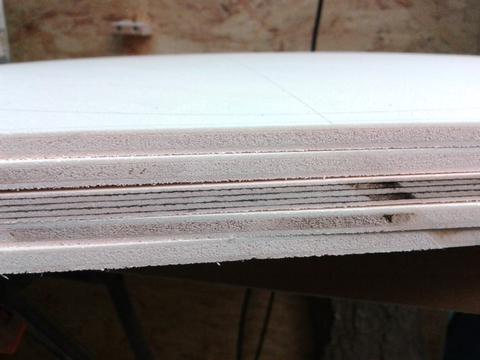 I made the wheels out of a sandwich of 5 layers of 6mm plywood
with birch plywood in the middle. But it didn't came out the way I
expected and wobbled a little bit. Maybe I'll make some new wheels from
only two layers of 15mm birch plywood in the future.
I made the wheels out of a sandwich of 5 layers of 6mm plywood
with birch plywood in the middle. But it didn't came out the way I
expected and wobbled a little bit. Maybe I'll make some new wheels from
only two layers of 15mm birch plywood in the future.
Thanks Matthias for the wonderful plans,
Marius.
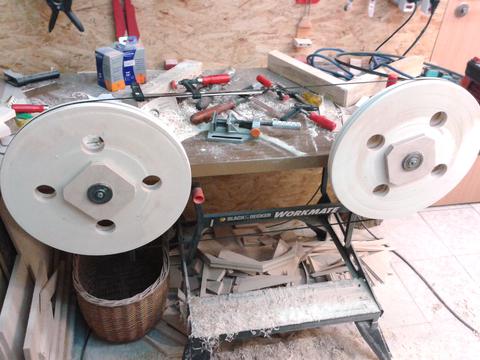
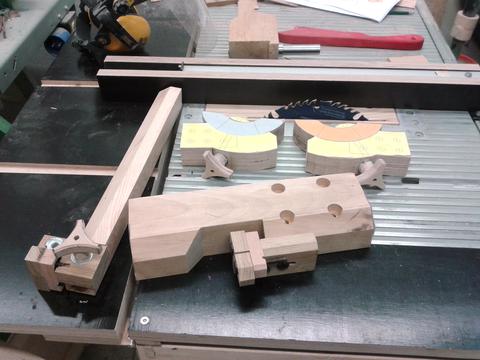
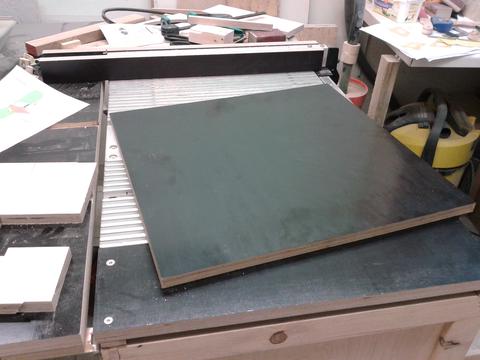 The table top is a piece of "Siebdruck" as it's called it in Germany.
It's some 18mm birch plywood with a nice shiny black veneer on the top.
The table top is a piece of "Siebdruck" as it's called it in Germany.
It's some 18mm birch plywood with a nice shiny black veneer on the top.
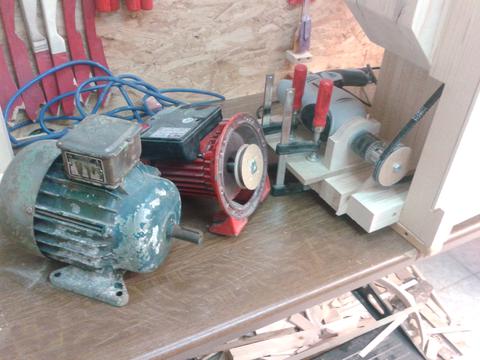 I had a little bit of a problem with the motor. I wanted to use
the red one. It's 1 hp and I got for 5€, but unfortunately it runs the
wrong direction and could not reverse it without damaging it. So at this
point I upgraded my shop with 3-phase power. I got this other 1.5 hp
motor for 10€, but unfortunately it didn't work anymore. I powered it
with a drill until I had a suitable motor.
I had a little bit of a problem with the motor. I wanted to use
the red one. It's 1 hp and I got for 5€, but unfortunately it runs the
wrong direction and could not reverse it without damaging it. So at this
point I upgraded my shop with 3-phase power. I got this other 1.5 hp
motor for 10€, but unfortunately it didn't work anymore. I powered it
with a drill until I had a suitable motor.
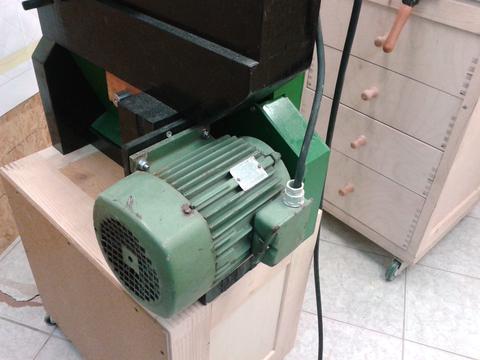 A few weeks later I got a
very nice and heavy 2hp slow-speed (6-pole) motor with a pulley on it, again
for 10€. It works perfectly. With it only 1000 rpm I could make the
pulleys nearly the same size.
A few weeks later I got a
very nice and heavy 2hp slow-speed (6-pole) motor with a pulley on it, again
for 10€. It works perfectly. With it only 1000 rpm I could make the
pulleys nearly the same size.
The rolling stand I made for this saw is a little bit bigger than the one from
the plans because my motor is so heavy the whole saw tended to tip over on a
smaller stand.
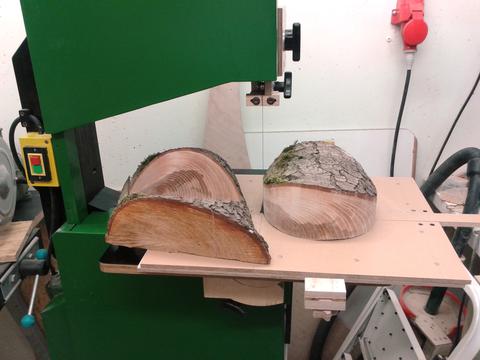 I also made a adjustable circle cutting jig with different inserts...
I also made a adjustable circle cutting jig with different inserts...
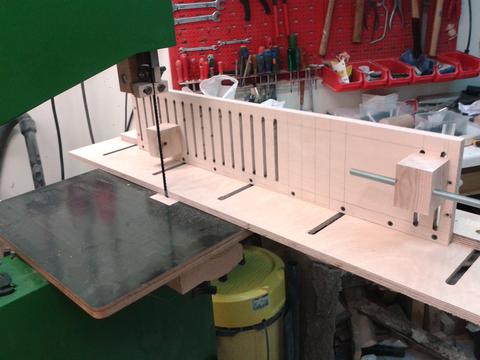 ... and big sled to cut up logs.
... and big sled to cut up logs.
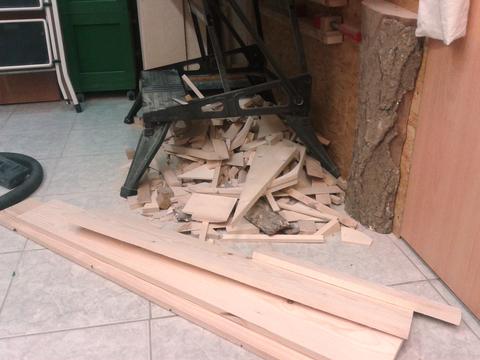 And all the scrap wood and left over boards from this project.
And all the scrap wood and left over boards from this project.
You can see the bandsaw in action in this video:
Walnut bowl blanks
Originally published July 2014.
Update Feb 2015:
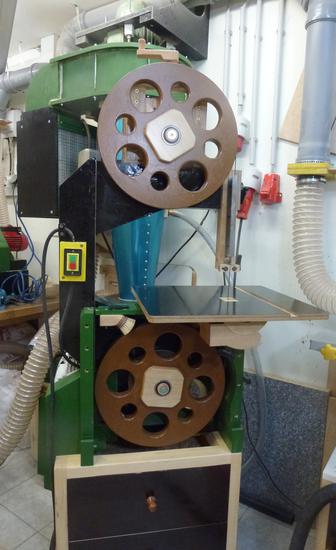 I wanted to make new wheels for my bandsaw, because I discovered some
big problems with my current ones and their design. In the video I
explain the problem and show, very detailed, how I made the new wheels.
I wanted to make new wheels for my bandsaw, because I discovered some
big problems with my current ones and their design. In the video I
explain the problem and show, very detailed, how I made the new wheels.
I was never really pleased with the blade-speed. It was too slow, because of a fallacy in the first place and I wasn't even touching the potential of the 2hp.
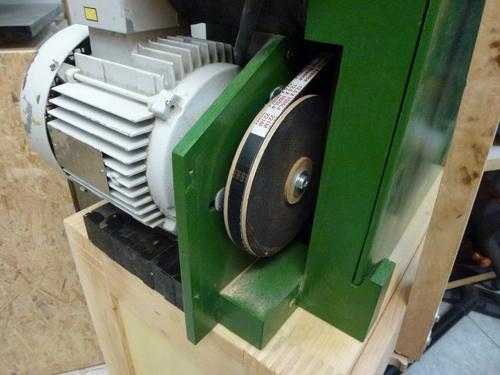 So I installed a new motor, which I got for free.
(A factory was getting rid of some old machines and I managed to some a
machine part that had a motor attached). This one seems to be a perfect
woodworking motor, because it originally run a transmission in an
oil bath. So the motor itself is sealed very well and sawdust won't
affect its performance. It is also a 2hp motor, but runs at 1400rpm and
now I got a higher blade-speed (21 m/s) It seems really fast, but I
looked at some good commercial bandsaws and they all have blade speeds
between 15 and 25 m/s, so I thought my blade-speed should be allright
and it turned out, it is. But because the motor only has a flange and no
foot, it was harder to install it. I made a new, thicker belt cover which
the motor is bolted onto.
So I installed a new motor, which I got for free.
(A factory was getting rid of some old machines and I managed to some a
machine part that had a motor attached). This one seems to be a perfect
woodworking motor, because it originally run a transmission in an
oil bath. So the motor itself is sealed very well and sawdust won't
affect its performance. It is also a 2hp motor, but runs at 1400rpm and
now I got a higher blade-speed (21 m/s) It seems really fast, but I
looked at some good commercial bandsaws and they all have blade speeds
between 15 and 25 m/s, so I thought my blade-speed should be allright
and it turned out, it is. But because the motor only has a flange and no
foot, it was harder to install it. I made a new, thicker belt cover which
the motor is bolted onto.
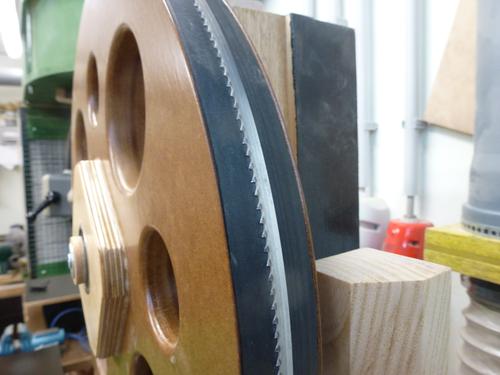 The new wheels came out really really nice and work much better than the old ones.
The new bearings I installed are quieter, the wheels themselves are
now flat and I managed to get just a minimum of side-wobble (the plywood
sandwich from the old wheels was not flat...) and the new wheel design
prevents the sawdust from being caught between the wheel and the tire.
The new wheels came out really really nice and work much better than the old ones.
The new bearings I installed are quieter, the wheels themselves are
now flat and I managed to get just a minimum of side-wobble (the plywood
sandwich from the old wheels was not flat...) and the new wheel design
prevents the sawdust from being caught between the wheel and the tire.
When I had the new wheels finished I was curious about their weight, because MDF is heavier than plywood. The old wheels out of plywood weigh about 1860 grams and the new MDF wheels about 2960 grams. So over 1kg heavier, but I got less vibration with them. Tells me that I balanced them good enough.
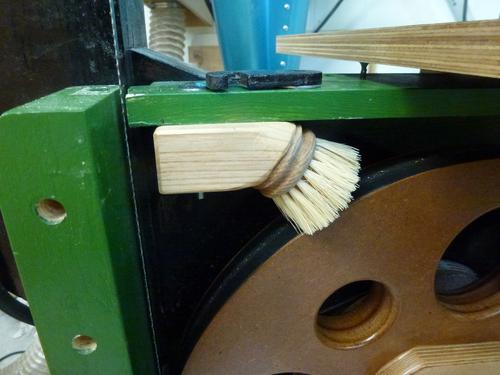 For the new wheels I wanted to try out a wheel brush. The brush is
normally used with a separate handle for cleaning dishes. You can adjust
it back and forth and also turn the brush, so if parts of it wear out I
can turn it a little bit and have fresh bristles.
For the new wheels I wanted to try out a wheel brush. The brush is
normally used with a separate handle for cleaning dishes. You can adjust
it back and forth and also turn the brush, so if parts of it wear out I
can turn it a little bit and have fresh bristles.
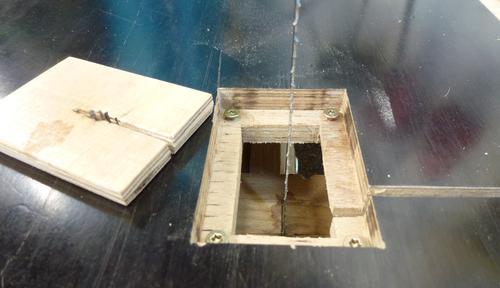 I also made another change to my saw. When I built the saw and routed
the groove for the replaceable insert plate I routed a little bit too
deep. So the insert plate always was a little bit too low and small
pieces really liked to get stuck on the table edge. To fix that I went
with thinner plywood for the inserts (6,5mm) and put four screws in the
corners of the groove. They allowed my to make really precise
adjustments and bring the insert level with the table. Another advantage
is that sawdust doesn't affect the fit of the inserts as much.
I also made another change to my saw. When I built the saw and routed
the groove for the replaceable insert plate I routed a little bit too
deep. So the insert plate always was a little bit too low and small
pieces really liked to get stuck on the table edge. To fix that I went
with thinner plywood for the inserts (6,5mm) and put four screws in the
corners of the groove. They allowed my to make really precise
adjustments and bring the insert level with the table. Another advantage
is that sawdust doesn't affect the fit of the inserts as much.
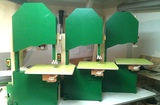 Alois Schmidt's three bandsaws
Alois Schmidt's three bandsaws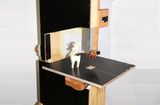 Hessam Sane's wooden bandsaw
Hessam Sane's wooden bandsaw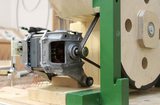 Mario Zimmermann's bandsaw
Mario Zimmermann's bandsaw